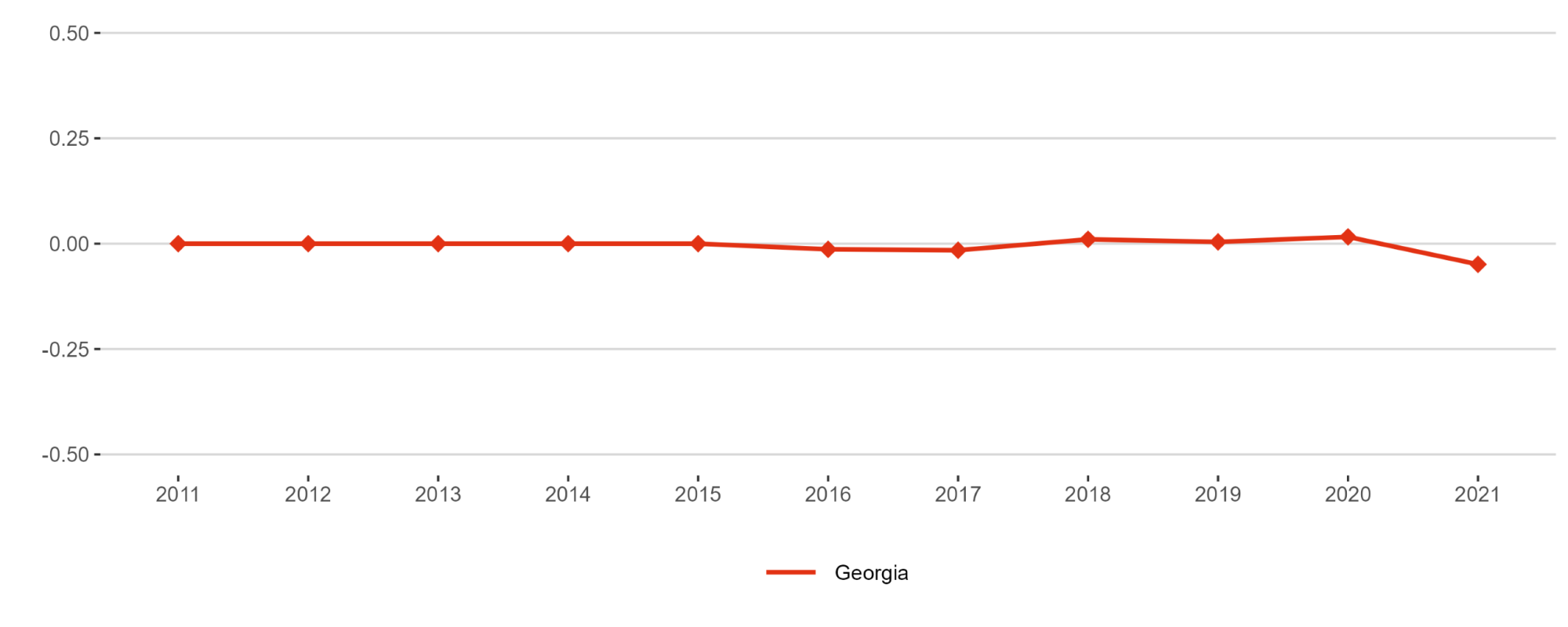ERA Country Report 2023
Georgia
Edited by Jonas Antanavičius (Visionary Analytics)
as part of ‘Development of the ERA Scoreboard, the ERA Dashboard and the Regular Reports’ project for the European Commission, Directorate-General for Research and Innovation under Framework Contract N° 2018/RTD/A2/OP/PP-07001-2018 Lot 2 (EDAR)
Click here to download this country report![]()
- Table of contents
-
ERA Country Report 2023: Georgia
1. National context
1.1. Overview of the ERA policy agenda implementation
1.2. Policy context
2. Assessment of the Implementation of the ERA Policy Agenda and ERA Priorities
2.1. ERA Priority 1: Deepening a truly functional internal market for knowledge
2.2. ERA Priority 2: Taking up together the challenges posed by the twin green and digital transition and increasing society’s participation in the ERA
2.3. ERA Priority 3: Amplifying access to research and innovation excellence across the Union
2.4. ERA Priority 4: Advancing concerted research and innovation investments and reforms
3. Country-specific drivers and barriers
4. Final remarks
5. Bibliography
6. Annexes
6.1. Annex 1: Graphs
ERA Country Report 2023: Georgia
|
Key takeaways:
|
1. National context
1.1. Overview of the ERA policy agenda implementation
Georgia is partially dedicated to advancing the European Research Area (ERA) Policy Agenda. It is one of the countries outside the EU keenly aligning its actions with the ERA objectives. Overall, Georgia has committed to the final 17 ERA Policy Actions.
The Georgian strategy towards the implementation of the ERA Policy Agenda and subsequent priorities and actions involves a range of policy initiatives. The most comprehensive policy document is the Unified National Strategy of Education and Science of Georgia for the period 2022-2030, which encompasses an extensive range of policies regarding Education, Training, Science and Research. ^ This document has a twofold purpose: presenting a critical assessment of the current Georgian situation regarding education and science and outlining central objectives to achieve within the established timeframe. The outlined strategy mainly focuses on the first two ERA priorities: 1. Deepening a truly functioning market of knowledge and 2. Taking up the challenges posed by twin green and digital transition and increasing society’s participation in the ERA.
1.2. Policy context
In the Georgian national context, two ministries and their subsidiary bodies are designated to coordinate and administer research and innovation (R&I) activities. Regarding academic research, the Ministry of Education, Science and Youth (MES) is responsible for the Shota Rustaveli National Science Foundation of Georgia (SRNSFG), which supports the development of the Science, Technology and Innovation (STI) system in Georgia. ^ In terms of industry research, the Ministry of Economy and Sustainable Development oversees the Georgian Innovation and Technology Agency (GITA), which is tasked with fostering an effective system in Georgia for the development of innovation and technology. The agency also promotes the commercialisation of innovative knowledge, aiming to integrate the latest technologies across all economic sectors and establish a necessary platform for innovative development.
With these organisational structures in place, Georgia has made notable strides in the European R&I landscape. Since 2016, Georgia has been associated with Horizon 2020 and took a significant step by becoming a fully associated member of Horizon Europe on 7 December 2021. ^ This membership permits Georgian researchers and institutions to actively participate in EU-funded R&I projects, with the MES coordinating Horizon Europe's activities in the country.
GITA has been at the forefront of bolstering the nation's innovative ecosystem. This agency was instrumental in executing the National Innovation Ecosystem (GENIE) Project, which ran from March 2016 to October 2021. The GENIE Project's goal was to augment the innovative endeavours of Georgian firms and individuals, propelling them into the digital economy.
The core policy initiative in place involves the Unified National Strategy of Education and Science of Georgia for 2022-2030. The Ministry of Education, Science and Youth of Georgia has compiled an Action Plan for the biennium 2022-2024 based on goals and indicators. Every year, the action plan is assessed through a monitoring report. Strategic alignment with the ERA Policy Agenda has also been expressed by SRNSFG in the Integration Guide and Impact Tools 2023 – 2028. However, this document does not propose or mention specific projects, objectives or indicators but rather focuses on a general commitment to the integration with the ERA and the improvement of the R&I ecosystem in Georgia.
2. Assessment of the Implementation of the ERA Policy Agenda and ERA Priorities
Chapter 2 has two objectives: 1) It qualitatively assesses the state-of-play of the implementation of the ERA actions that Georgia has committed to; 2) It quantitatively assesses the country’s progress towards achieving the ERA priorities as set out on the Pact for Research and Innovation in Europe. The information presented comes mainly from the analysis of statistical data retrieved from the UNESCO Institute for Statistics, the National Statistics Office of Georgia, and the ERA Scoreboard and Dashboard, as well as qualitative desk research on national documents. Additionally, general indicators for the overall R&I system are outlined in Table 1. More detailed information on the data and graphs can be found in Annex 1.
|
Indicator |
Most Recent Metric |
|
Gross Domestic Expenditure on R&D (GERD) as a percentage of GDP |
0.30 (2020) |
|
Researchers (in full-time equivalent) per million inhabitants |
1,623.7 (2021) |
Source: compiled by research team based on the ERA Scoreboard and Dashboard indicators
2.1. ERA Priority 1: Deepening a truly functional internal market for knowledge
2.1.1. State of play in the implementation of the ERA Actions
In line with the ERA Priority Area 1, Georgia is working towards establishing a robust internal knowledge market, aiming for comprehensive integration within the European research sphere. This is supported by the declared commitment to all ERA Policy Actions. This section further describes relevant national initiatives for each committed ERA Action. For ERA Actions 2, 3, and 7, Georgia participates in the EU level activities, but no specific initiatives at the national level were identified because of them being voluntary.
Regarding ERA Action 1:Enable the open sharing of knowledge and the re-use of research outputs, including through the development of the European Open Science Cloud (EOSC) , Georgia demonstrates its commitment by associating with European initiatives, namely Horizon 2020, Horizon Europe, and the European Open Science Cloud (EOSC). This European-led open platform emphasises shared research data across disciplines and borders. Moreover, the 2021 amendment to Order N1245475 by the MES, supporting the development of open science, and the formation of the EOSC National Working Group in 2022, manifest Georgia's determination in this direction. ^ In its response to the EOSC survey, Georgia indicated that it considers the FAIRisation of data in its funding activities and, in addition, the appointment of a Mandated Organisation to the EOSC Association is in planning.
Addressing ERA Action 4: Promote attractive research careers, talent circulation and mobility, Georgia supports the development of sustainable research careers and broader mobility within the ERA. The SRNSFG initiated collaborations with European funding agencies and inaugurated the EURAXESS Georgia portal to provide Georgian researchers with a gateway to the ERA Talent Platform. ^
Under ERA Action 5: Promote gender equality and foster inclusiveness, Georgia emphasises gender equality and inclusivity. In the 2022-2030 Unified National Strategy of Education and Science details that the country has initiated a comprehensive Gender Audit and plans to introduce policies to increase female representation in STEM sectors and leadership roles. ^
Georgia's alignment with ERA Action 6: Protect Academic Freedom in Europe is reflected in its defence of academic freedom, as constitutionally guaranteed. ^ Beyond the constitution, the country actively promotes academic ethics, transparency, and integrity. The Ministry of Education, Science and Youth stands at the forefront of this mission, with specific objectives to update anti-plagiarism and integrity protocols in 50% of the higher education institutions (HEIs) by 2030. ^
Aligning with ERA Action 8: Strengthen sustainability, accessibility and resilience of research infrastructures in the ERA, Georgia delineates a clear trajectory to increase research's sustainability, accessibility, and resilience. Among the initiatives promoted by the SRNSFG on this theme are access to international publications on platforms like ELSEVIER and SCOPUS and the creation of Georgia’s Science Portal. ^ The 2022-2030 Unified National Strategy further amplifies these objectives, with the establishment of a National Technology Transfer Office and national open-access platforms. ^ Financial commitments, including increased funding towards research infrastructure until 2030 further reinforce Georgia's commitment.
Lastly, the SRNSFG initiated an international partnership with the University of Oxford for the "Georgian Studies Research Programme'' and a memorandum with the German Research Foundation, ^ underscoring Georgia's aspiration to internationalise its scientific endeavours in line with ERA Action 9: Promote a positive environment and level playing field for international cooperation based on reciprocity.
2.1.2. Progress towards achieving ERA Priorities
The indicators that illustrate Georgia’s development in Sub-priority 1.3: Gender equality, equal opportunities for all and inclusiveness are the proportion of papers with mixed-gender authorship (Figure 3 in Annex 1), and the proportion of women in authorships of the top 10% most cited publications (Figure 4 in Annex 1). For the first one, Georgia has seen a steady increase from 44.7 % in 2010 to 51.7% in 2020.
Regarding the second indicator, the latest comparable data (2018) indicates that the proportion of women in the authorship of the top 10% of papers in Georgia is around the 23%. Nonetheless, examining past data reveals that Georgia had a percentage of the top 10% of women authorships of 52.4% in 2015, representing a considerable difference. The data indicates a progressive trend in gender equality and inclusion for Georgia, although there is notable variability in the data, particularly concerning Georgia's second indicator.
With regard to Sub-priority 1.6: Scientific Leadership, Georgia, while not yet on par with the EU-27 Member States, demonstrates a commitment to the principle of academic freedom, boasting an Academic Freedom Index of 0.83 (Figure 6 in Annex 1). This index represents the freedom of scholars in Georgia to undertake research, disseminate knowledge, participate in open intellectual discourse, collaborate with fellow scholars, ensure the institutional autonomy of universities, guarantee a safe campus environment, and maintain the freedom of expression regarding their views on political matters. Regarding scientific contributions on the global stage, in 2020, Georgia had 3.7% of its scientific publications among the top 10% most cited worldwide (Figure 5 in Annex 1).
In relation to Sub-priority 1.7: Global engagement, Georgia has witnessed a significant rise in international co-publications with non-EU partners per 1,000 researchers in the public sector (Figure 7 in Annex 1). Specifically, in 2010, Georgia reported 76.9 international co-publications per 1,000 researchers (in full-time equivalent) in the public sector, but in 2022, Georgia's figure increased to 269.8. These figures suggest that Georgia is increasing international cooperation, but still it should be noted that Georgia is still considered a non-EU partner, therefore its collaboration with other non-EU members might be compensated by increasing collaboration with European partners.
2.2. ERA Priority 2: Taking up together the challenges posed by the twin green and digital transition and increasing society’s participation in the ERA
2.2.1. State of play in the implementation of the ERA Actions
Georgia has committed to all actions under this Priority Area and its responsive measures encompass initiatives spanning from digital to environmental realms, collectively fostering a holistic approach to transition. This section further describes relevant national initiatives for each committed ERA Action. Although Georgia participates in all EU-level activities, no specific initiatives at the national level were identified for ERA Actions 10 and 13.
Georgia's commitment to a greener future is evident through its energy infrastructure plans. The country substantially leverages hydroelectric dams, which presently supply 75% of its energy needs. ^ Following the draft Long-Term Low-Emission Development Strategy (LT-LEDS) Georgia envisions increasing hydro's contribution to its electricity consumption to at least 85% and initiating 150 MW of wind power generation by 2030, resonating with ERA Action 11: An ERA for green energy transformation.
In the pursuit of green transformation, Georgia recognises the crucial role of Small and Medium Enterprises (SMEs) and seeks to bolster their eco-innovation endeavours. A notable initiative in this realm is the market assessment under the EU4Environment programme, identifying Agriculture and Hospitality as sectors optimal for eco-innovation. This is coupled with the small grants programme by Georgia's Innovation and Technology Agency (GITA) which funds novel green projects, particularly within these sectors, propelling SMEs to embrace sustainable methods and products.
Georgia's stride towards an effective digital transition is underlined by the extensive Public Administration Reform (PAR). Inaugurated in 2015, this reform seeks to ensure an accountable, transparent, and proficient public administration system. Among its achievements, the country has developed a range of pivotal digital platforms and solutions, such as the Electronic Public Financial Management (ePFM) system, Digital Signature Infrastructure, and Data Exchange Infrastructure, ensuring fluid data sharing across both public and private sectors. Spearheading this digital drive is the Digital Governance Agency, responsible for Digital Georgia's evolution and the coordination of the overarching GovTech strategy. ^ These comprehensive efforts underline Georgia's alignment with ERA Action 12: Accelerate the green/digital transition of Europe´s key industrial ecosystems.
Georgia remains committed to narrowing the gap between scientific discourse and the general population. This objective is championed by numerous SRNSFG’s programmes and grants, such as the "Scientific Publication Grants," "Scholarship Call for Young Scientists" and the "Targeted Grant Call for Science Popularisation". ^ These initiatives serve ERA Action 14: Bring Science closer to Citizens, aiming to cultivate a deeper societal engagement with scientific advancements.
2.2.2. Progress towards achieving ERA Priorities
With regard to Sub-priority 2.1: Challenge-based ERA actions, OECD patents on environmental technologies indicator (Figure 8 in Annex 1) reveals that Georgia demonstrates distinct trends over the designated decade. Commencing at 22.5% in 2009, there was a decline to 7.41% in 2010. Subsequent years observed oscillations, culminating in a peak of 23.68% in 2015, before moderating to 18.08% in 2018 (latest data available). In a comparative context, Georgia’s metrics for green patents displayed a good level of volatility. The data indicates a strong tendency in Georgia towards the development of green technology, however, with the release of more recent data, it will be possible to determine whether this result is established over time.
As for Sub-priority 2.4: An active citizen and societal engagement in R&I in all its dimensions, the specific indicator employed measures the number of publications focusing on 'social innovation' or 'social entrepreneurship' per million population (Figure 9 in Annex 1). Georgia's data on research on social innovation manifests sporadic activity. Most of the years under observation, starting from 2009 to 2014, and then from 2017 to 2021, recorded a value of zero. However, there were intermittent surges in 2015 and 2017, with values of 0.269 and 0.536, respectively. Overall, Georgia's engagement in this specific research area appears to be nascent but sporadic.
2.3. ERA Priority 3: Amplifying access to research and innovation across the Union
2.3.1. State of play in the implementation of the ERA Actions
In the context of the ERA Priority 3, Georgia's commitment is evident in its involvement in various programmes and projects. This section further describes relevant national initiatives for each committed ERA Action. However, besides the participation in all EU-level activities, no specific voluntary initiatives at the national level were identified for ERA Action 17.
Georgia's involvement in the European Cooperation in Science and Technology (COST) association since 2022 is relevant to ERA Action 16: Improve EU-wide Access to excellence. In terms of fostering regional development through smart specialisation, the Ministry of Regional Development and Infrastructure of Georgia initiated a pilot smart specialisation strategy in the Imereti region in 2019.
Additionally, Georgia pledged to introduce ERA Hubs, envisioned to bolster competitive R&I ecosystems across the EU, thereby addressing territorial disparities and facilitating the movement of talents and investments. ^ A consultation process on future bilateral R&I cooperation activities aims to enhance and interlink R&I excellence within the ERA framework. ^ Two further initiatives, "Teaming for Excellence" and "Excellence Hubs", align with Georgia's broader objectives under this priority area. ^ The former seeks to either establish new or upgrade existing centres of excellence in widening countries by facilitating partnerships between institutions in these nations and prominent scientific entities across Europe. Meanwhile, "Excellence Hubs" focuses on enhancing innovation by fostering connections between academia, business, government, and society in Widening countries.
2.3.2. Progress towards achieving ERA Priorities
Sub-priority 3.1: More investments and reforms in countries and regions with lower R&I performance seeks to incentivise low R&I-performing countries and integrate them more cohesively into the European research landscape. Regarding the data on the increase in percentage points of total R&D expenditure expressed as a percentage of GDP (Figure 10 in Annex 1), Georgia's trajectory in R&D expenditure as a percentage of GDP has remained relatively static from 2011 to 2015, registering a consistent 0.00%. This was followed by minor decreases in 2016 and 2017, with -0.01% and -0.02%, respectively. However, a marginal recovery was observed in subsequent years, culminating in an increment of 0.02% in 2020, only to decline by -0.05% in 2021. These figures coupled with the data on R&I expenditures as a percentage of GDP (Figure 1 in Annex 1) indicate some stagnation in the sector.
2.4. ERA Priority 4: Advancing concerted research and innovation investments and reforms ^
2.4.1. State of play in the implementation of the ERA Actions
In the framework of the ERA Priority Area 4 Georgia has demonstrated active participation and commitment through various actions and associated policies.
Georgia's commitment to Action 19: Establish an efficient and effective ERA monitoring mechanism is substantiated by the Unified Strategy 2022-2030 that embodies a comprehensive monitoring system to assess whether strategic frameworks align with the defined vision and goals. Integral to this system's operation is the Department of International Relations and Strategic Development of the Ministry of Education, Science and Youth of Georgia. They bear the responsibility for coordinating data collection, preparing regular reports and assessing the alignment of activities with strategic goals. ^
Stakeholder engagement is a pivotal element in this strategy, with both physical meetings and virtual means employed to include various stakeholders in the monitoring and evaluation process. Adding to this, the Article 7 Agreement on joining Horizon Europe by Georgia ^ dictates that the participation of Georgia in the Horizon Europe Programme will be continuously monitored in partnership with the Commission.
3. Country-specific drivers and barriers
The drivers for Georgia's engagement in relation to the ERA Policy Agenda include European integration efforts wherein Georgia has established agreements and collaborations with European entities, such as the Association Agreement with the EU, participation in Horizon Europe, E4Environment, and the Erasmus Programme, with the nation's key documents reflecting an overarching ambition for the “European State Building”. ^ In terms of economic competitiveness, Georgia stands out for its relatively low bureaucracy and its competitiveness in terms of economic freedom and business facilitation. ^ When these characteristics are coupled with increasing collaboration between the private and public sectors, it may result in a thriving R&I ecosystem with several national hubs of excellence. The reform momentum suggests that there is an ongoing boost for reforms on a broad spectrum of sectors such as economic development, public administration, education, digitalisation, and infrastructure, all in line with Georgia’s effort to pursue the status of candidate member state in the EU, underscoring a proactive approach to address systemic challenges and enhance the country's R&I ecosystem.
On the other hand, one of the barriers for Georgia encompass funding concerns. The level and modality of R&I funding, combined with the public organisations involved, present challenges. The funding level is significantly lower than the EU-27 average, and the trend appears stagnant when observing the increase (in percentage points) of GERD as a percentage of GDP. Despite the annual increase of the overall R&D budget, this relative scarcity of considerable funding further obstructs the creation of solid science-business partnerships, essential infrastructure, and progress towards the green/digital transition. Moreover, as seen in the previous chapter, Georgia’s implementation of the ERA Policy Agenda is often limited to participation in EU-level activities as an associated country rather than introducing additional national initiatives. However, there are signs of increasing proactivity and the aforementioned reform momentum.
4. Final remarks
Georgia is actively engaged in the ERA across all four priority areas, signalling a commitment to a unified European research landscape. The country has shown initiative by aligning with ERA policies, participating in significant programmes like Horizon 2020, Horizon Europe and EOSC, and launching local strategies like the "Unified National Strategy of Education and Science of Georgia 2022-2030".
Strong European integration efforts, reform momentum and economic competitiveness signify the country's commitment to aligning with EU standards and fostering a robust R&I ecosystem. On the other hand, this is contrasted by relatively stagnant R&D funding, as illustrated through several indicators. Yet the analysis of the data presented in this report highlights promising commitments and strong ambitions coupled with a positive trend over time.
There has been considerable progress in areas such as open science, gender equality in STEM, digital transition, and green energy. Additionally, endeavours like the Public Administration Reform and smart specialisation strategies denote Georgia's proactive approach. However, there remains a scarcity of comprehensive quantitative data against the ERA Scoreboard and Dashboard indicators to conclusively gauge Georgia's progress and impact in the context of ERA objectives.
5. Bibliography
“About the Foundation”, The Shota Rustaveli National Science Foundation of Georgia website, available at: https://rustaveli.org.ge/eng/misia-miznebi-amotsanebi
“About Us”, The Georgian Agency for Innovation and Technology website, available at: https://gita.gov.ge/en/about
“Action Plan”, The Shota Rustaveli National Science Foundation of Georgia website, available at: https://rustaveli.org.ge/eng/samoqmedo-gegma
“Association to Horizon Europe: Georgia”, The European Commission DG Research and Innovation website, available at: https://research-and-innovation.ec.europa.eu/strategy/strategy-2020-2024/europe-world/international-cooperation/association-horizon-europe/georgia_en
Article 27 of the Constitutional Law of Georgia No 2071 of 23 March 2018 on Academic Freedom, available at: https://matsne.gov.ge/en/document/view/30346?publication=36
EU4Environment (2021) Market Assessment and Policy Analysis of the Eco-innovation Landscape in Georgia, available at: https://www.eu4environment.org/app/uploads/2023/06/Market-Assessment-and-Policy-Analysis-of-the-Eco-innovation-Landscape-in-Georgia.pdf
“Georgia: Overview”, European Open Science Cloud website, available at: https://eosc.eu/tripartite-collaboration/georgia
“GENIE: National Innovation Ecosystem Project”, The Georgian Agency for Innovation and Technology website, available at: https://gita.gov.ge/en/genie
Government of Georgia (2015) Public Administration Reform, available at: https://www.gov.ge/wp-content/uploads/2022/07/danarthi-0_veb-bukleti.pdf
Ministry of Education and Science of Georgia (2022) 2022-2024 Action Plan of the Unified National Strategy of Education and Science for 2022-2030, available in Annex 2. 2022-2024 Action Plan
Ministry of Education and Science of Georgia (2022) 2022-2030 Unified National Strategy of Education and Science of Georgia, available at: 2022-2030 Unified National Strategy of Education and Science of Georgia
Ministry of Education and Science of Georgia (2022) Monitoring Report of the 2022-2024 Action Plan of the Unified National Strategy of Education and Science for 2022-2030, available at: 2022 Monitoring Report of the 2022-2024 Action Plan of the Unified National Strategy of Education and Science for 2022-2030
National Statistics Office of Georgia (2018) Research and Development Statistics, available at: https://www.geostat.ge/media/26779/Research-and-Development_2018.pdf
Shota Rustaveli National Science Foundation of Georgia (2023) Integration guide and impact tools with an accent on the obligations of the Shota Rustaveli National Science Foundation of Georgia, available at: https://rustaveli.org.ge/res/docs/f045cf1b4335bfea145759bd30b6cb9232ed9fdf.pdf
“Shota Rustaveli National Science Foundation of Georgia signed a Memorandum of Understanding with the German Research Foundation”, The Shota Rustaveli National Science Foundation of Georgia website, available at: https://rustaveli.org.ge/eng/siakhleebi/rustavelis-fondsa-da-germaniis-kvlevit-fonds-shoris-urtierttanamshromlobis-memorandumi-gaformda-
“SRNSFG announces 2023 Joint call for “Georgian Studies Research programme” of SRNSFG and the University of Oxford”, The Shota Rustaveli National Science Foundation of Georgia website, available at: https://rustaveli.org.ge/eng/mimdinare-konkursebi/fondi-atskhadebs-shota-rustavelis-saqartvelos-erovnuli-sametsniero-fondisa-da-oqsfordis-universitetis-saqartvelos-shemstsavleli-metsnierebebis-ertoblivi-kvleviti-programis-2023-tslis-sagranto-konkurss
United Nation Development Programme (2023) Georgia’s Long-Term Low-Emission Development Strategy, available at: https://www.undp.org/sites/g/files/zskgke326/files/2023-07/undp-georgia-eu4climate-leds-summary-eng.pdf
‘What is the Greek Ombudsman? Role and mission’, the Greek Ombudsman website, available at: http://www.synigoros.gr/?i=stp.en.what
World Bank (2022) Georgia: Promoting Digital Transformation through GovTech: A Whole-of-Government Approach, available at: https://thedocs.worldbank.org/en/doc/bd555a478d4a4a63acc0739084838b20-0350062022/original/GovTech-Case-Studies-Georgia-Promoting-Digital-Transformation-through-GovTech.pdf
6.Annexes
6.1.Annex 1: Graphs
The 2023 ERA Scoreboard and Dashboard indicators used in the country report are presented in this annex. Detailed information on the data sources, description of the indicators, time period for which the data is available, and the necessary calculations can be found in the ERA Scoreboard and Dashboard Methodology Report. The most recent available data for each indicator has been used.
General Indicators


Priority 1: Deepening a truly functioning internal market for knowledge
Sub-priority 1.3: Gender equality, equal opportunities for all and inclusiveness
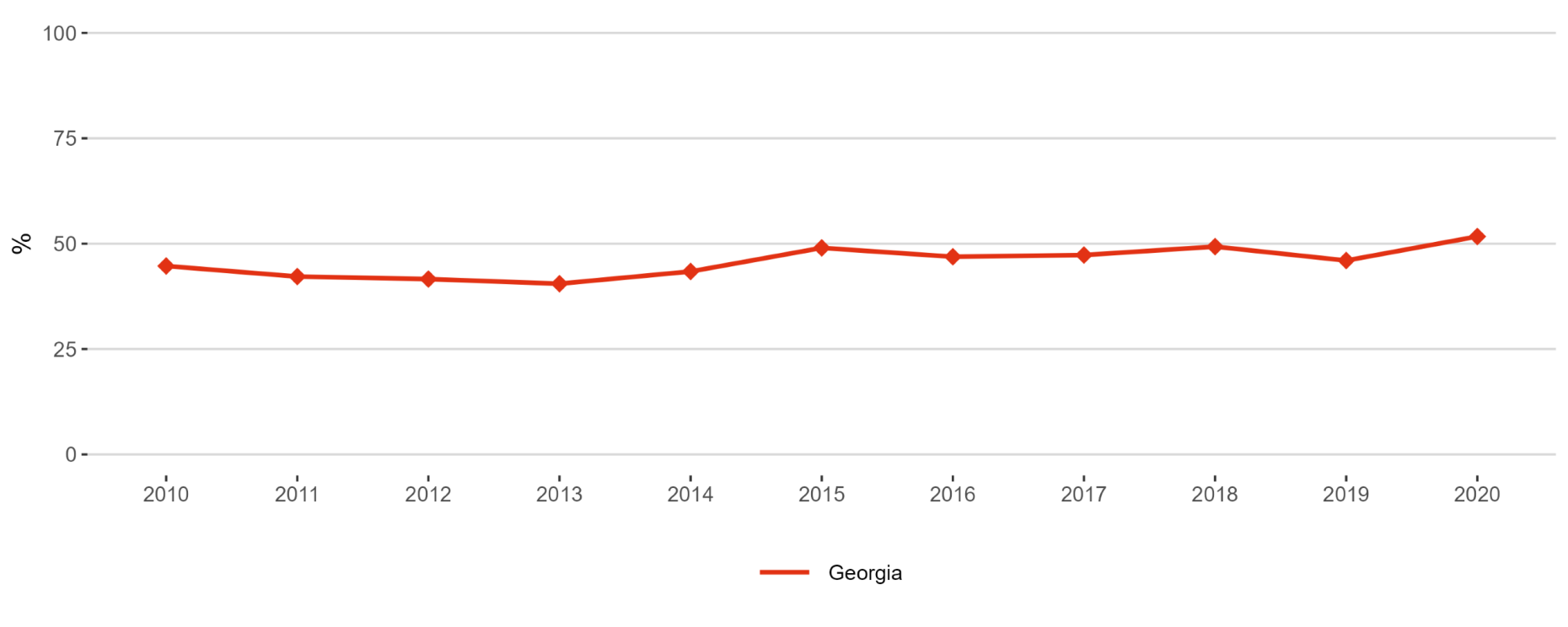
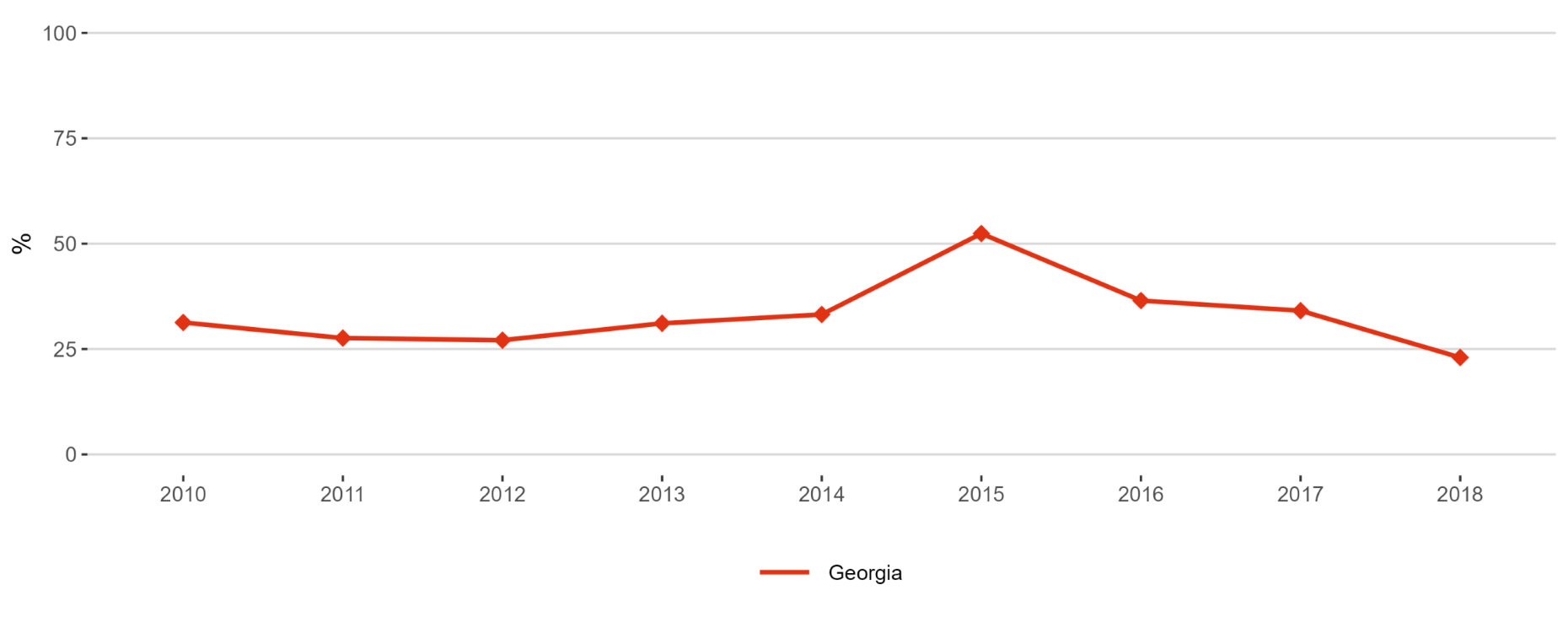
Sub-priority 1.6: Scientific leadership
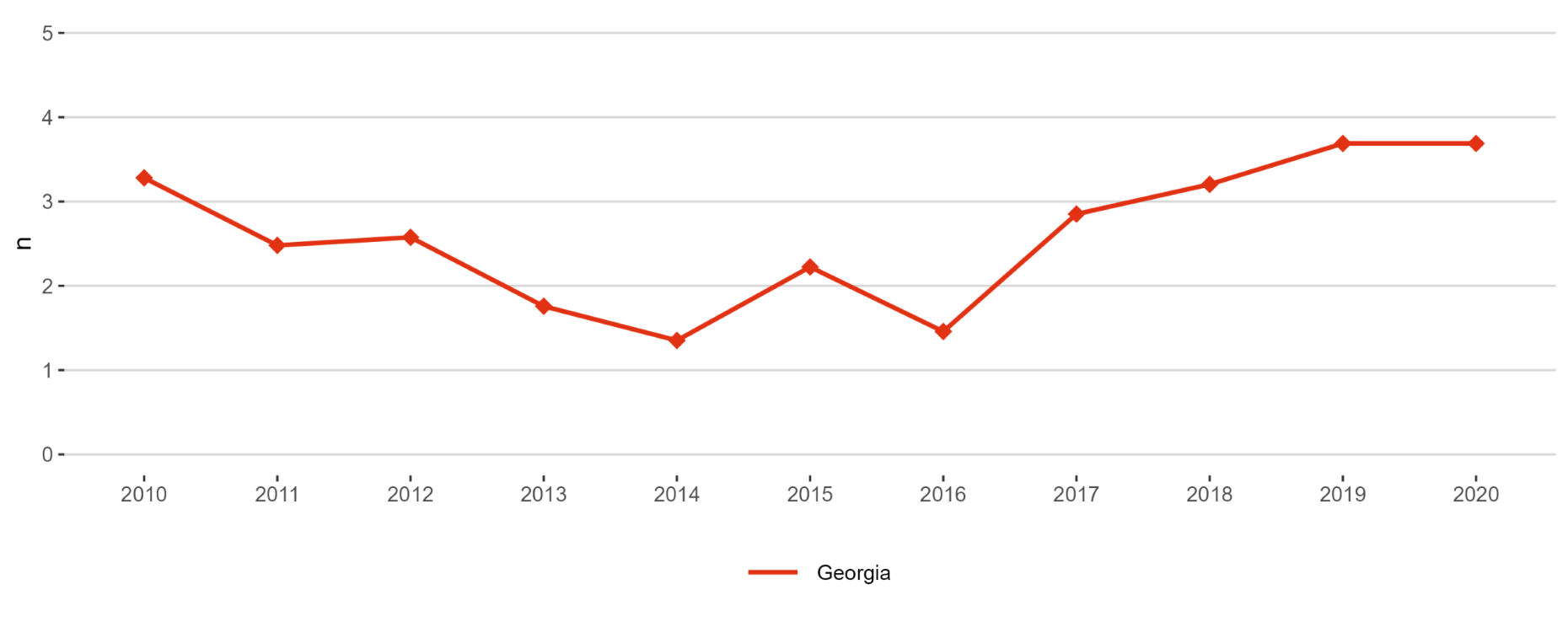
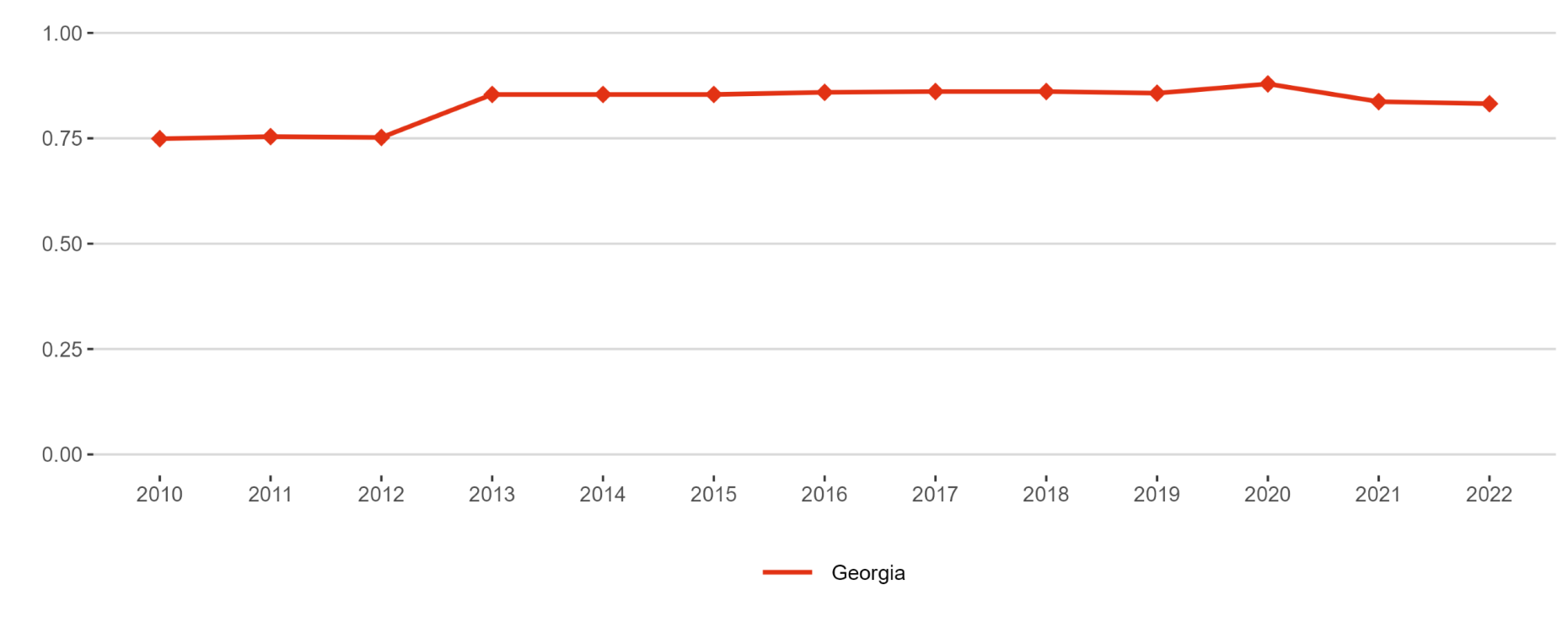
Sub-priority 1.7: Global engagement
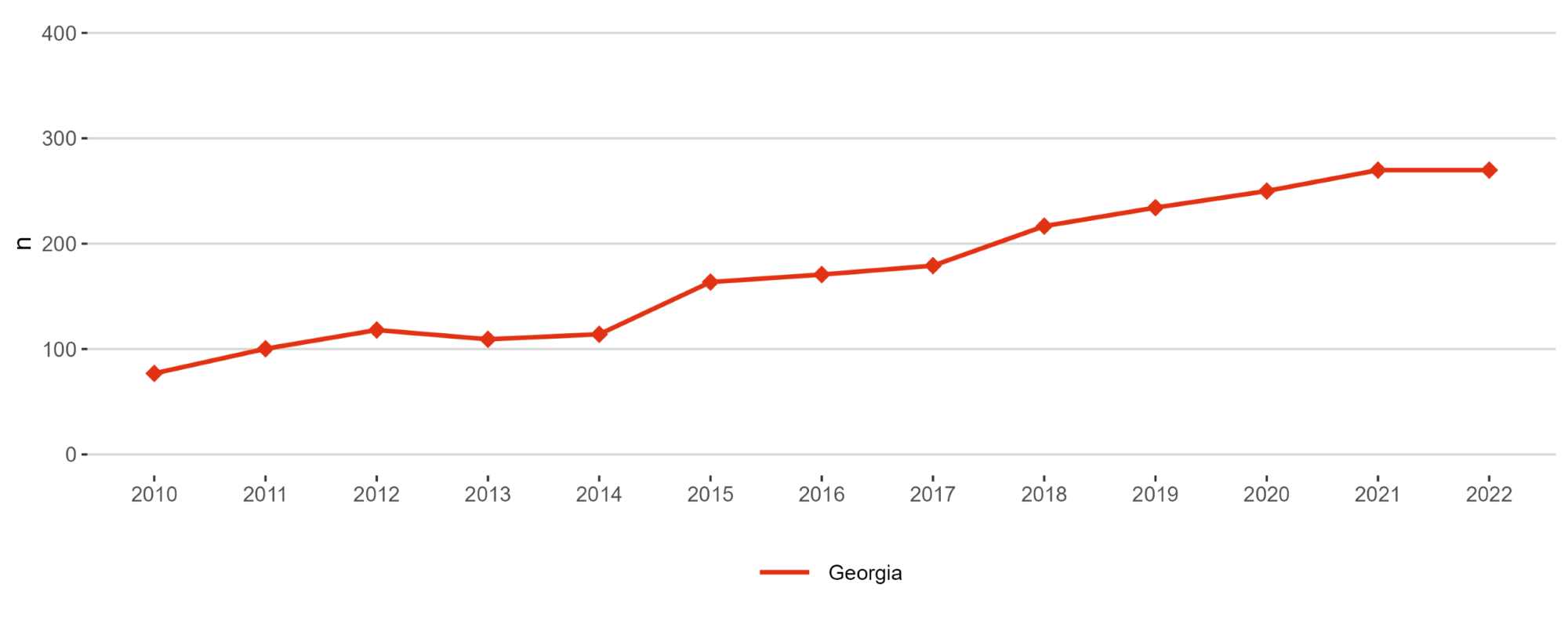
Priority 2: Taking up together the challenges posed by the twin green and digital transition and increasing society’s participation in the ERA
Sub-priority 2.1: Challenge-based ERA actions
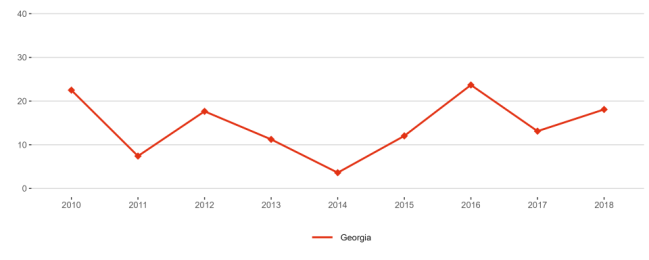
Sub-priority 2.4: An active citizen and societal engagement in R&I in all its dimensions

Priority 3: Amplifying access to research and innovation excellence across the Union
Sub-priority 3.1: More investments and reforms in countries and regions with lower R&I performance
